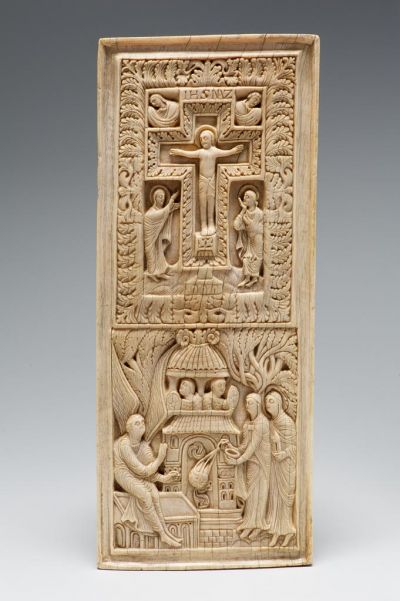
Ivory panel (part of a book binding) - Scenes from the Passion-the Crucifixion and The Maries at the Sepulchre --plaque for book cover
| Accession Nr.: | 18859 |
|---|---|
| Date of production: |
10th century
|
| Place of production: | Sankt Gallen |
This narrow, upright-format board shows two central events of the New Testament, Christ’s death on the cross and the empty tomb indicating the Resurrection. The upper field, framed with acanthus leaves, is dominated by a Christ’s cross standing on a base, in an ornate setting, the title board at the top , and the figures of Mary and St John the Evangelist at the bottom. It combines two different, independently formed “picture in a picture” formats, the reduced version of the narrative, multifigure Calvary compositions frequent in Carolingian art, and the crucifix as an independent cultic image. Above the arms of the cross is the symbol of the distressed universe, the embodiment of the Sun and the Moon. Underneath, an angel sits in front of a structure representing the Holy Tomb in Jerusalem, found empty by the women arriving with balms. The vegetation in the background is a reference to the garden, the site of the Resurrection. Only the soldiers are unusual: instead of sleeping guards, we see combat-ready soldiers looking out of the openings under the cupola of the buildings. The style of the carving is in general comparable to art works with Italian connections from the court school of Charles II the Bald (875–877). The etherially light, classical manner of the figures stands closest to the style of ivory carvings ascribed to the monk Toutilo of Sankt Gallen (active 895–912). The grooved profiling of the panel edges suggests that it was applied to a bookbinding by a metal plate. An ivory panel of similar working and size in Nuremberg (Germanisches Nationalmuseum), decorated with leaves and the figure of an eagle, has been proposed as the companion piece to the Budapest relief.
Following Adolph Goldschmidt, earlier research considered the Budapest relief to be the pendant of the ivory tablet held at the Germanisches Nationalmuseum in Nuremberg, which features leaves and the figure of an eagle, and has a very similar size (23.5 x 9.8 cm), border profile and carving style. However, since the set of the two tablets would not be justifiable in iconographic terms, more recent research has rejected the hypothesis that the Budapest and the Nuremberg carvings were two wings of a single diptych.
Literature
- Szerk.: Horváth Hilda, Szilágyi András: Remekművek az Iparművészeti Múzeum gyűjteményéből. (Kézirat). Iparművészeti Múzeum, Budapest, 2010. - Nr. 2. (Takács Imre)
- Recht Roland, Périer-d' Leteren Catheline, Griener Pascal: The Grand Atelier. Pathways of Art in Europe, 5th - 18th centuries. Palais des Beaux-Arts, Brussels, Brussels, 2007. - Nr. II.30.
- Szerk.: Pataki Judit: Az idő sodrában. Az Iparművészeti Múzeum gyűjteményeinek története. Iparművészeti Múzeum, Budapest, 2006. - Nr. 146. (Nagy Györgyi)
- Szerk.: Mikó Árpád: Jankovich Miklós (1773-1846) gyűjteményei. Magyar Nemzeti Galéria, Budapest, 2002. - Nr. 51. (Marosi Ernő)
- katalógust írta: Rozsondai Marianne, Szirmai János: Művészi könyvkötések régen és ma. Kiállítás elmúlt korok kötéseiből és Szirmai János (Hollandia) modern alkotásaiból. Országos Széchényi Könyvtár, 1986. - Nr. 1.
- Szerk.: Voit Pál: Elefántcsont-faragások. Régiségek könyve. Gondolat Kiadó, Budapest, 1983. - 1. kép (Koroknay Éva)
- Koroknay Éva: Művészi könyvkötések 1700 előtt. Iparművészeti Múzeum, Budapest, 1983. - Nr. 1.
- Szerk.: Miklós Pál: Az Iparművészeti Múzeum gyűjteményei. Magyar Helikon, Budapest, 1979. - p. 97.
- Szerk.: Radocsay Dénes, Farkas Zsuzsanna: Az európai iparművészet remekei. Száz éves az Iparművészeti Múzeum 1872-1972. Iparművészeti Múzeum, Budapest, 1972. - p. 22. Nr. 6.
- Goldschmidt Adolph: Die Elfenbeinskulpturen aus der Zeit der Karolingischen und Sächsischen Kaiser. VIII.- XI. Jahrhundert. Cassirer, Berlin, 1914. - Nr. 165.
